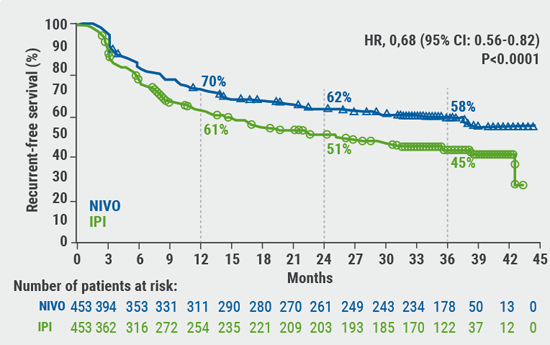PAOLA-1/ENGOT-ov25 is the first phase 3 trial to examine the efficacy and safety of a pharmacological inhibitor of the enzyme poly-ADP ribose polymerase (PARP) with bevacizumab as first-line maintenance therapy in patients in women with newly-diagnosed advanced ovarian cancer who had a complete or partial response to first-line treatment with platinum-based chemotherapy and bevacizumab, with and without a BRCA mutation. This international, academic-led trial enrolled 806 patients. After completing first-line chemotherapy, patients were randomly allocated 2:1 to olaparib or placebo, in addition to the standard of care, bevacizumab monotherapy. They received olaparib for up to 24 months and bevacizumab for 15 months in total. The primary outcome was investigator-assessed progression-free survival.
The median follow-up was 24 months in the olaparib arm and 22.7 months in the placebo arm. Median progression-free survival was 22.1 months in the olaparib group and 16.6 months in the placebo group (HR 0.59; 95% CI 0.49-0.72; P<0.0001). In prespecified subgroup analyses, the progression-free survival benefit of olaparib vs placebo was even more pronounced in patients with a BRCA mutation and in those with homologous recombination deficiency (HRD), with hazard ratios of 0.31 and 0.33, respectively. Median progression-free survival with olaparib reached 37.2 months in patients with a BRCA mutation and in patients with HRD. Prof. Ray-Coquard noted that randomisation in PAOLA-1/ENGOT-ov25 started a median 6 weeks after the last cycle of chemotherapy, whereas most previous trials started randomisation with the first cycle of chemotherapy. "It is an important point to consider when comparing the results to other data," she said.
- Ray-Coquard IL et al. ESMO Congress 2019. Abstract LBA2
Posted on
Previous Article
« 25% reduction in the risk of death in patients with nmCRPC treated with apalutamide Next Article
Ceritinib in ALK+ NSCLC brain metastases »
« 25% reduction in the risk of death in patients with nmCRPC treated with apalutamide Next Article
Ceritinib in ALK+ NSCLC brain metastases »
Table of Contents: ESMO 2019
Featured articles
Interview with ESMO President Prof. Josep Tabernero
Breast Cancer
Triple negative breast cancer gets positive news: KEYNOTE-522 interim results
CDK4/6 inhibitors change landscape of breast cancer treatment: 2 studies
Veliparib-chemo combo prolongs survival without disease progression in some advanced breast cancer patients
Lung Cancer
Improved response rates without survival benefit with pembrolizumab in pretreated mesothelioma
Frontline ipilimumab/nivolumab improves OS in advanced NCLSC
First-line osimertinib significantly lengthens OS in NSCLC
Liquid biopsy to decide the best treatment for NSCLC
Melanoma
Long-term data from CheckMate 067
Adjuvant nivolumab provides benefit
Nivolumab+ipilimumab superior to monotherapy for melanoma brain metastases
GI Cancers
Preoperative chemotherapy for colon cancer
Nivolumab improves OS in advanced oesophageal cancer
Liquid biopsy identifies relapse in patients with colorectal cancer after surgery
In hepatocellular carcinoma, CheckMate 459 misses OS endpoint, but some interesting trends emerge
Heavily pre-treated GIST: ripretinib improves PFS
FGFR2+ cholangiocarcinoma: pemigatinib active as second-line treatment
IDH1+ cholangiocarcinoma: phase 3 results show improved PFS
Advanced colorectal cancer and BRAF mutations: triplet combination improves survival
Genitourinary Cancers
25% reduction in the risk of death in patients with nmCRPC treated with apalutamide
Enfortumab vedotin and pembrolizumab in advanced bladder cancer: initial results
PARP inhibition in selected patients slows progression on advanced prostate cancer
PFS extension with immunotherapy + chemotherapy in urothelial cancer
Third-line in mCRPC: CARD trial
Prostate cancer: spare radiotherapy after surgery
Novel mode of action for kidney cancer treatment
Gynaecological Cancers
Ovarian cancer patients benefit from combined maintenance therapy
Combination of PARP inhibition plus chemotherapy in ovarian cancer
PFS benefit with niraparib as first-line maintenance in ovarian cancer
CNS Tumours
Ceritinib in ALK+ NSCLC brain metastases
Solid Tumours/Pan-Tumour Data
Mixed data: AMG 510 in tumours with KRASG12C
DNA profiling of carcinoma of unknown primary should inform treatment
Larotrectinib: safe and effective in TRK fusion-positive tumours
Related Articles
November 26, 2019
Third-line in mCRPC: CARD trial

November 26, 2019
Adjuvant nivolumab provides benefit
© 2024 Medicom Medical Publishers. All rights reserved. Terms and Conditions | Privacy Policy

